Media
Summary
Due to breaking news, our lead story is about the collapse of the Arecibo telescope platform and its dish. Plus magnetars, gamma-ray bursts, sunspots, asteroids, dark matter, and a Kickstarter to preserve an historic observatory in Japan.
Transcript
This is the Daily Space for today, Tuesday, December 1, 2020. I am your host, Dr. Pamela Gay.
And I am your host, Beth Johnson.
And we are here to put science in your brain.
Today we have two breaking news stories that I’d like to start with. As this is breaking news, we don’t have a lot of details, and we expect to follow up on both these stories later this week.
Our first story is a sad continuation of our coverage of Arecibo Observatory. This morning, astronomers around the world are mourning the collapse of the observatory’s main instrument platform. This 900-ton platform fell, and the tops of the support towers collapsed, destroying much of the dish. This is the kind of destruction the facility can’t recover from. As you may remember, the National Science Foundation (NSF) had recently declared they would not be funding repairs because the situation was judged too dangerous. Because it’s hard to say goodbye even to a telescope, many had worked on fundraising solutions. Now it’s clear the NSF made the right choice, recognizing that people are more important than telescopes.
The images we’re sharing come from Deborah Martorell, a meteorologist for WAPA.tv and a NASA solar system ambassador.
Science is always going to have bad moments. This is not the first time a radio telescope has collapsed. Green Bank Observatory’s 300-meter dish literally fell to pieces in 1988. A new telescope was built with updated everything so the kind of science it did could continue. We don’t know what will happen this time, but I for one hope that a new radar facility will be created in Puerto Rico to continue Arceibo’s legacy of shining light on asteroids that get too close to our planet Earth.
Alright, that news sucked. As a reminder that humans can accomplish great things, prior to going on the air we, got confirmation that China has successfully landed Chang’e 5 on the moon. If all goes well, this mission will collect two kilograms of rocks and return them to the Earth in the next two weeks.
Next up is a story I wanted to bring you last week in the hopes that our community could contribute some images. The National Solar Observatory predicted a large sunspot cluster would emerge in time for the U.S. Thanksgiving holiday. That cluster did indeed emerge, and the observatory got a great image in h-alpha of the sunspots just peeking around the limb of the Sun. You can see the image on our blog at DailySpace.org.

Sunspots are nothing new; however, we are just starting to move out of a solar minimum, which means those dark spots have been few and far between, if not altogether nonexistent. And the real story here is not so much the what but the how.
Sunspots occur when the magnetic field lines of the Sun get tangled up, like a knot of spaghetti noodles. Different latitudes of the Sun rotate and circulate at different velocities, causing the magnetic fields to drag against each other and twist together. The spots are cooler than the surrounding surface, which causes their dark appearance. And we are definitely interested in those spots because when the magnetic fields snap and realign, there is usually a solar flare. The bigger the grouping of sunspots, the greater the potential for a solar flare and the larger the possible flare could be.
A solar flare releases massive amounts of radiation into space, and that radiation can cause issues with radar communication here on Earth. Of even greater concern is the possibility of a coronal mass ejection, or CME, which has the potential to disrupt power grids and satellites.
So scientists have been working diligently to understand solar cycles and sunspots to keep us forewarned. And this recent grouping was predicted five days in advance of coming around the limb of the Sun using helioseismology. Per the release: [T]he team has been “listening” to changing sound waves from the Sun’s interior which beckon the arrival of the large feature. Recent changes in these sound waves pointed to the imminent appearance of a new sunspot group which we can now see from Earth near the eastern solar limb.
The process works similarly to how we listen to sound waves traveling through the Earth’s interior to determine the planet’s structure. The release goes on to explain: Helioseismology can highlight structures on the Sun that cannot yet be seen from Earth. Millions of sound frequencies bounce freely throughout the Sun’s interior, like a bell. Regions of strong magnetic fields perturb these sound waves, thus a change in wave signal measurements indicates that sunspots may be present.
The team predicted the sunspot grouping on November 18 and imaged it on November 24. That is a decent amount of lead time for a potential threat to our infrastructure when we previously had 15-18 hours of warning for a fast-moving CME, after the fact.
Also, if you have pictures of these sunspots, we will share them out on our social media with your credit. We can be found at CosmoQuestX on both Twitter and Instagram, so feel free to tag us.
As much as we wish all the cool stuff in the sky could be seen with backyard telescopes, the reality is, some stuff can’t be seen at all. Specifically, dark matter, one of the dominant ingredients in our universe, defies direct detection and can only be seen by how its gravity affects galactic rotations and galaxy movements and by how it twists the light of the distant objects.
Our current theories for cosmology generally tell a story of massive dark matter halos collapsing together gravitationally and pulling into their centers the kind of matter that we can see — the material capable of forming stars and other luminous structures. In this story, there is space for halos to collect more or less luminous matter and for there to be places that have only dark matter and nothing luminous at all. What was not explained in this story is how you can get a luminous galaxy with no dark matter, something we actually find now and then.
And, it turns out, the reason our story doesn’t explain how these systems can form is that they probably don’t form this way.
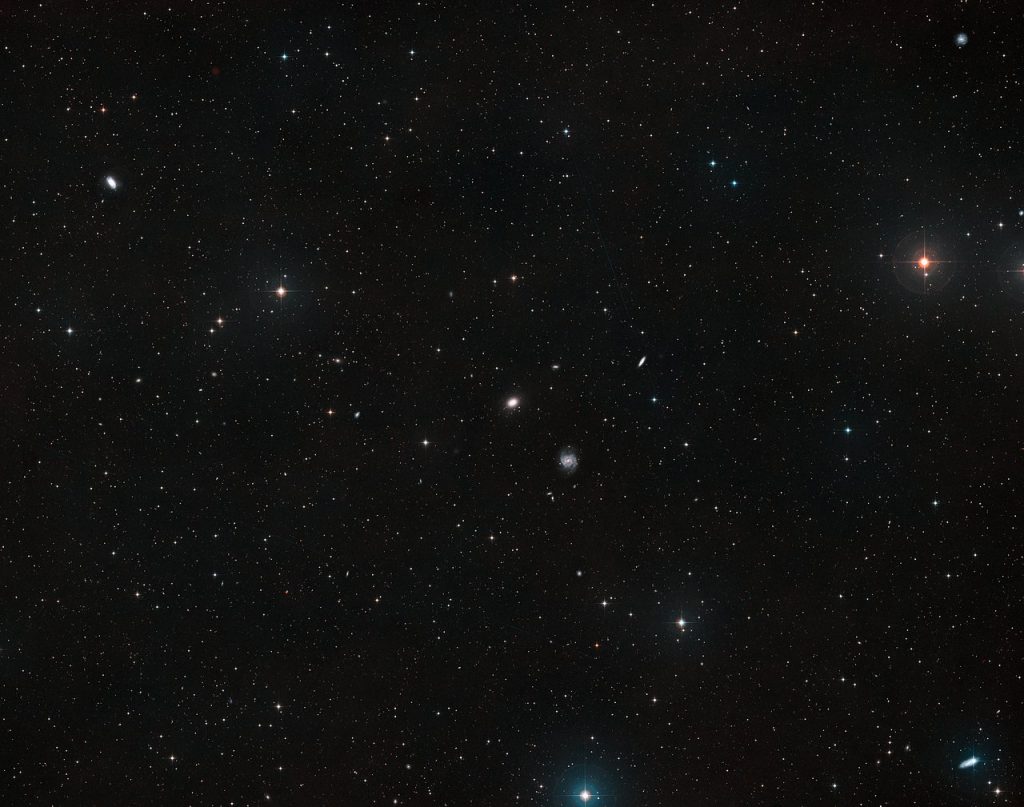
In a new paper appearing in The Astrophysical Journal with lead author Mireia Montes, astronomers describe how Hubble Space Telescope (HST) images of the dark matter-free galaxy NGC 1052-DF4 appears to have recently undergone some kind of a collision or interaction with the massive galaxy NGC 1035, an interaction that appears to have stripped the dark matter from NGC 1052-DF4. According to Montes: We used Hubble in two ways to discover that NGC 1052-DF4 is experiencing an interaction. This includes studying the galaxy’s light and the galaxy’s distribution of globular clusters.
Specifically, they found that 7% of the galaxy’s luminous material had been torn into tidal tails, and the globular cluster distribution was consistent with the clusters being stripped out of the system.
This result is a good indicator that, while the dark matter of the galaxy was evaporated from the system, the stars are only now starting to suffer the disruption mechanism, explained team member Ignacio Trujillo of the Instituto de Astrofísica de Canarias in Spain. In time, NGC 1052-DF4 will be cannibalized by the large system around NGC 1035, with at least some of their stars floating free in deep space.
More work is needed to see if other low dark matter and dark matter-free galaxies also show signs of ongoing disruption. It may turn out that these systems are simply caught in the middle of being consumed, where the dark matter was eaten away first, with the stars saved for dessert.
Once again, I bring you a story that may help shed light on the formation of our own solar system by looking at distant stars. In a new paper accepted in the Monthly Notices of the Royal Astronomical Society with lead author Joshua Lovell, researchers detail the observations of fast-moving carbon monoxide gas flowing away from a young, low-mass star.
Per the press release: The detection was made with the Atacama Large Millimetre/submillimetre Array (ALMA) in Chile, as part of a survey of young ‘class III’ stars, reported in an earlier paper. Some of these class III stars are surrounded by debris discs, which are believed to be formed by the ongoing collisions of comets, asteroids and other solid objects, known as planetesimals, in the outer reaches of recently formed planetary systems. The leftover dust and debris from these collisions absorbs light from their central stars and re-radiates that energy as a faint glow that can be studied with ALMA.
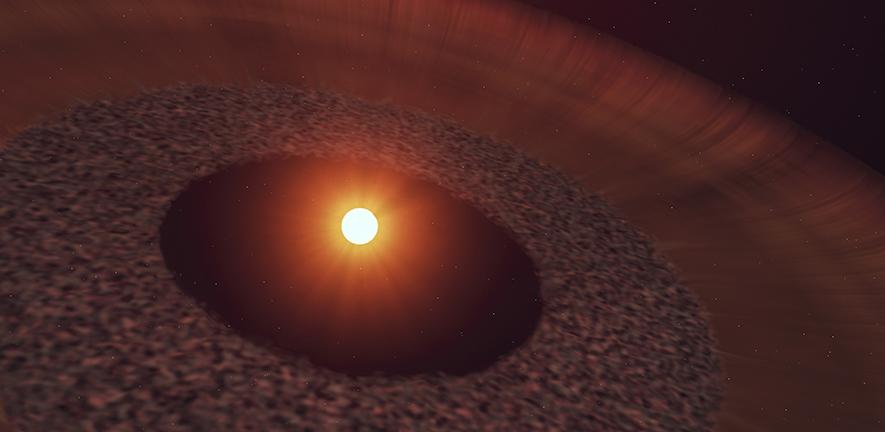
The star, NO Lup, is a class-III star and about 70% the size of our Sun. These types of stars are expected to only have cold, dim dust left by this point in their evolution as the biggest gas giants have formed, and all that should remain is the equivalent of our own Kuiper Belt and Oort Cloud. NO Lup is the first class-III star observed to have carbon monoxide, and even more intriguing is the speed and scale of the ejection.
Grant Kennedy, who led the modelling work, explains: We found a simple way to explain it: by modelling a gas ring but giving the gas an extra kick outward. Other models have been used to explain young discs with similar mechanisms, but this disc is more like a debris disc where we haven’t witnessed winds before. Our model showed the gas is entirely consistent with a scenario in which it’s being launched out of the system at around 22 kilometers per second, which is much higher than any stable orbital speed.
Some of the gas may even come from the collision of asteroids or sublimation of their various ices. The release goes on to note: There has been recent evidence of this same process in our own solar system from NASA’s New Horizons mission when it observed the Kuiper Belt object [Arrokoth] in 2019 and found sublimation evolution on the surface of the comet, which happened around 4.5 billion years ago.
We may be witnessing the destruction of comets in a system 400 light-years away. As co-author Mark Wyatt said: While we have seen gas produced by planetesimals in older systems, the shear rate at which gas is being produced in this system and its outflowing nature are quite remarkable and point to a phase of planetary system evolution that we are witnessing here for the first time.
This observation only lasted thirty minutes. Imagine how much more they could learn with more observing time. And now we add even more pieces to the planetary system formation puzzle.
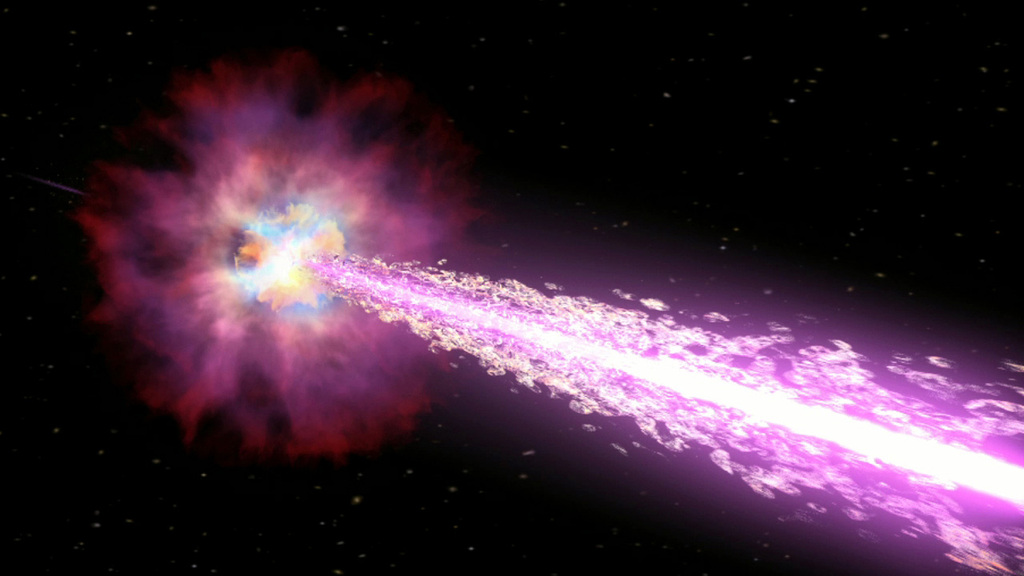
And from one kind of star, we now turn to another, very different, kind of star, or at least a stellar death. I’m here to talk about short gamma-ray bursts (GRBs) that are linked to neutron star mergers and the associated kilonova that go with them. These detonations – in gamma-ray light – are very briefly the most luminous objects in the universe. For over a decade, people have been looking for ways to use these objects and other, longer GRBs as standard candles to measure distances to the farthest corners of our universe. Exploding white dwarfs all explode with the same mass (with some exceptions), and thus explode with the same luminosity (with some exceptions).
Neutron stars, however, have a variety of sizes and when they explode in pairs, they can explode in a variety of different ways, and there is no linear relationship between their luminosity and distance. Instead, however, it appears that where a line can’t fit the data, a plane maybe can.
A new paper to appear in The Astrophysical Journal with lead author Maria Fainotti describes a fundamental plane for neutron stars that allows their luminosity to be predicted based on the duration of the X-ray plateau phase and the luminosity of the gamma-ray peak. The work is still messy; by which I mean there is still a lot of noise due to a combination of these objects being rare and very rarely close enough to accurately measure.
For us to be able to accurately use kilonovae and their associated short GRBs as standard candles, we need to be able to calibrate them. To understand distances in the universe, we need overlapping methods that allow us to measure distances in more than one way. For the nearest stars, we use parallax, like a surveyor, to measure distances based on triangles. From there we use pulsating stars like RR Lyrae and Cepheid variables that are sometimes close enough for parallax measurements but can be seen as far away as nearby galaxies. These galaxies allow us to calibrate type 1a supernovae, and in a perfect universe, those type 1a supernovae will allow us to calibrate these short GRBs.
While there are other ways to measure distances, they haven’t allowed this potential plane to be well defined. There is a lot of noise, and we have a long way to go before we can use distant GRBs to measure parameters of the universe beyond what we measure with supernovae.
Here is to hoping we see GRBs in systems we’ve previously seen with Type 1a supernovae.
My next story returns to the theme of graduate students doing good work.
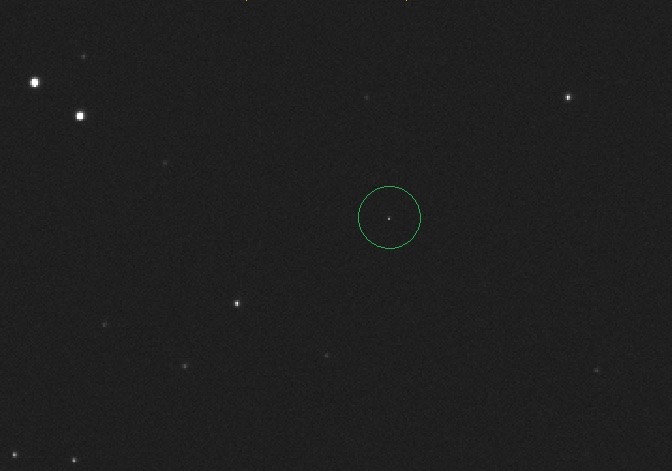
Cole Gregg is a grad student at Western University in Ontario, Canada. Like the rest of us, Gregg is stuck working from home, unable to travel. He has, however, remote access to the Astrocamp telescope in Nerpio, Spain. While using the telescope on November 18, Gregg noticed an object moving through his field of view that turned out to be an as-yet-undiscovered asteroid. He and his professor worked together and determined that the asteroid is about 50-100 meters in diameter and passed through near-Earth space.
The asteroid now has the temporary designation ALA2xH while the Minor Planet Center confirms the observation and determines that it is unique. Unfortunately, weather conditions have not been cooperative on the mountaintop where the remote observatory sits. We hope Gregg’s discovery is confirmed and look forward to a new telephone number for his asteroid.
And now for something entirely different, we look at enigmatic binary systems that emit gamma rays. Physics and astrophysics really are a continuum of sciences where the boundaries are often blurred, with astronomers working at particle accelerators and physicists looking for their own particle accelerators in the sky.
In a new paper appearing in Physical Review Letters with first author Hiroki Yoneda, researchers look at the gamma-ray binary LS 5039. In general, we know that gamma-ray binaries are made of a massive star and some sort of a compact companion, like a neutron star or black hole. Understanding exactly what the companion star might be is fairly complicated, but LS 5039 offered researchers two powerful hints.

Observations of the system discovered a pulse every nine seconds that is only visible in X-ray light. This is consistent with the behavior of a slowly rotating pulsar that is having its pulses in all other wavelengths masked by the companion star. They also detected extremely powerful Tera electron Volt gamma-ray photons that are consistent with a magnetic field three times more powerful than the magnetic field of a normal neutron star. This combination of a slow rotation and strong magnetic field indicates that the compact object in this particular system is a magnetar.
This is the first time a magnetar has been found in a binary system. The thirty-some-odd, previously-detected magnetars have all been isolated stars. It is unclear how common this kind of an arrangement may be, but now astronomers at least know what to look for when looking for paired off magnetars.
Finally, today is Giving Tuesday, and on this Giving Tuesday, it is only appropriate that we use our voices to uplift another cause. The Kwasan Observatory was established in 1929 at Kyoto University in Japan. Former observatory director and organizer of the Kickstarter, Kazunari Shibata, writes: Kwasan Observatory is the second oldest university observatory in Japan and has a unique research history, including key involvement in solar coronal research and pioneering the study of Martian meteorology. The observatory has also been a very important hub in Japan for outreach activities, so much so it is known as a “sacred place for amateur astronomy” in Japan. However, the financial future of Kwasan Observatory is uncertain, and we are looking for outside funding to support its continued existence.
A large part of the reason for the uncertain future of the observatory is that it is no longer used by Kyoto University due to the increasing light pollution. The university moved its operations to the Hida Observatory and Okayama Observatory, and the Okayama location essentially received the funding that was going to Kwasan back in 2018.
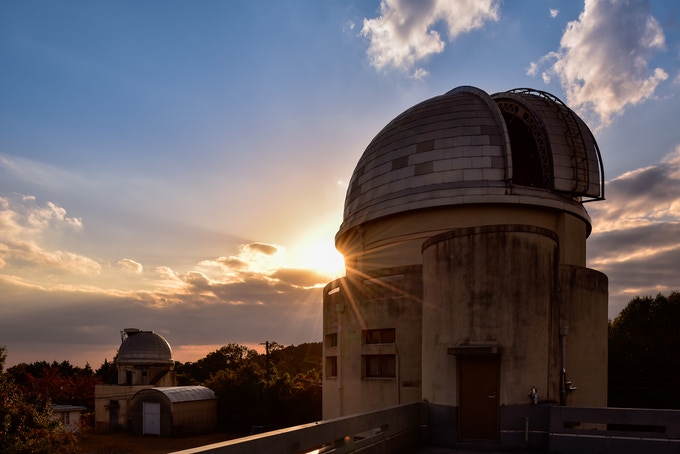
To keep the observatory up and running, Shibata’s Kickstarter is looking to raise US$10,000, and there ARE physical rewards involved, including an educational e-book and digital photos of astrophysicist and Queen guitarist Dr. Brian May visiting the observatory early this year, all to save a space that is important to the local amateur astronomy community and the astro-culture of Japan. We’ll have a link to the Kickstarter on our website, DailySpace.org, and you can find more information about the observatory and its history there.
This has been the Daily Space.
Learn More
Arecibo Observatory’s 305-Meter Telescope Suffers Collapse
National Solar Observatory Predicts a Large Sunspot for Thanksgiving
Ambushing a Standard Candle in Its Own Nest
- Space Science Institute press release
- “The X-Ray Fundamental Plane of the Platinum Sample, the Kilonovae, and the SNe Ib/c Associated with GRBs,” Maria Giovanna Dainotti et al., 2020, to appear in the Astrophysical Journal (preprint on arxiv.org)
Student First to Spot Asteroid Speeding Past Earth
Gamma-Ray Binary System May Be Powered by a Magnetar Star
- Kavil Institute for the Physics and Mathematics of the Universe press release
- “Sign of Hard X-Ray Pulsation from the Gamma-Ray Binary System LS 5039,” Hiroki Yoneda (1,2,3), Kazuo Makishima (1,2), Teruaki Enoto (4), Dmitry Khangulyan (5), Takahiro Matsumoto (1), & Tadayuki Takahashi (1,2), 2020 Sep. 8, Physical Review Letters (preprint on arxiv.org)
Gas Flowing Away from Young Star’s Asteroid Belt
- The University of Cambridge press release
- “Rapid CO Gas Dispersal from NO Lup’s Class III Circumstellar Disc,” J. B. Lovell et al., to be presented at Five Years After HL Tau, 7-11 December 2020.
- “ALMA Survey of Lupus Class III Stars: Early Planetesimal Formation and Rapid Disc Dispersal,” J. B. Lovell et al., 2020 Oct. 28, Monthly Notices of the Royal Astronomical Society (preprint on arxiv.org)
New Hubble Data Explains Missing Dark Matter in Galaxy
- Hubble ESA Information Centre press release
- “The Galaxy ‘Missing Dark Matter’ NGC 1052-DF4 Is Undergoing Tidal Disruption,” Mireia Montes et al., 2020 Nov. 26, Astrophysical Journal (preprint on arxiv.org)
Historic Kwasan Observatory Launches Kickstarter Project to Avert Closure
Credits
Written by Pamela Gay and Beth Johnson
Hosted by Pamela Gay and Beth Johnson
Audio and Video Editing by Ally Pelphrey
Content Editing by Beth Johnson
Intro and Outro music by Kevin MacLeod, https://incompetech.com/music/


 We record most shows live, on Twitch. Follow us today to get alerts when we go live.
We record most shows live, on Twitch. Follow us today to get alerts when we go live.